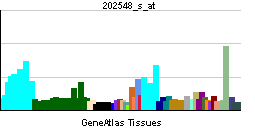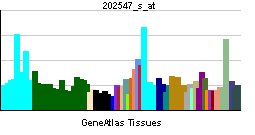ARHGEF7
| Rho guanine nucleotide exchange factor (GEF) 7 | |||||||||||||
|---|---|---|---|---|---|---|---|---|---|---|---|---|---|
 PDB rendering based on 1by1. | |||||||||||||
| |||||||||||||
| Identifiers | |||||||||||||
| Symbols | ARHGEF7 ; PAK3; BETA-PIX; COOL1; DKFZp761K1021; KIAA0142; KIAA0412; Nbla10314; P50; P50BP; P85; P85COOL1; P85SPR; PIXB | ||||||||||||
| External IDs | Template:OMIM5 Template:MGI HomoloGene: 2895 | ||||||||||||
| |||||||||||||
| RNA expression pattern | |||||||||||||
 | |||||||||||||
 | |||||||||||||
| More reference expression data | |||||||||||||
| Orthologs | |||||||||||||
| Template:GNF Ortholog box | |||||||||||||
| Species | Human | Mouse | |||||||||||
| Entrez | n/a | n/a | |||||||||||
| Ensembl | n/a | n/a | |||||||||||
| UniProt | n/a | n/a | |||||||||||
| RefSeq (mRNA) | n/a | n/a | |||||||||||
| RefSeq (protein) | n/a | n/a | |||||||||||
| Location (UCSC) | n/a | n/a | |||||||||||
| PubMed search | n/a | n/a | |||||||||||
Rho guanine nucleotide exchange factor (GEF) 7, also known as ARHGEF7, is a human gene.[1]
Rho GTPases play a fundamental role in numerous cellular processes that are initiated by extracellular stimuli that work through G protein coupled receptors. The encoded protein belongs to a family of cytoplasmic proteins that activate the Ras-like family of Rho proteins by exchanging bound GDP for GTP. It may form a complex with G proteins and stimulate Rho-dependent signals. This protein can induce membrane ruffling. Multiple alternatively spliced transcript variants encoding different isoforms have been described for this gene, but some of their full-length sequences have not been determined.[1]
References
Further reading
- Matoba R, Okubo K, Hori N; et al. (1994). "The addition of 5'-coding information to a 3'-directed cDNA library improves analysis of gene expression". Gene. 146 (2): 199–207. PMID 8076819.
- Nagase T, Seki N, Tanaka A; et al. (1996). "Prediction of the coding sequences of unidentified human genes. IV. The coding sequences of 40 new genes (KIAA0121-KIAA0160) deduced by analysis of cDNA clones from human cell line KG-1". DNA Res. 2 (4): 167–74, 199–210. PMID 8590280.
- Oh WK, Yoo JC, Jo D; et al. (1997). "Cloning of a SH3 domain-containing proline-rich protein, p85SPR, and its localization in focal adhesion". Biochem. Biophys. Res. Commun. 235 (3): 794–8. doi:10.1006/bbrc.1997.6875. PMID 9207241.
- Manser E, Loo TH, Koh CG; et al. (1998). "PAK kinases are directly coupled to the PIX family of nucleotide exchange factors". Mol. Cell. 1 (2): 183–92. PMID 9659915.
- Bagrodia S, Taylor SJ, Jordon KA; et al. (1998). "A novel regulator of p21-activated kinases". J. Biol. Chem. 273 (37): 23633–6. PMID 9726964.
- Turner CE, Brown MC, Perrotta JA; et al. (1999). "Paxillin LD4 motif binds PAK and PIX through a novel 95-kD ankyrin repeat, ARF-GAP protein: A role in cytoskeletal remodeling". J. Cell Biol. 145 (4): 851–63. PMID 10330411.
- Bagrodia S, Bailey D, Lenard Z; et al. (1999). "A tyrosine-phosphorylated protein that binds to an important regulatory region on the cool family of p21-activated kinase-binding proteins". J. Biol. Chem. 274 (32): 22393–400. PMID 10428811.
- Premont RT, Claing A, Vitale N; et al. (2000). "The GIT family of ADP-ribosylation factor GTPase-activating proteins. Functional diversity of GIT2 through alternative splicing". J. Biol. Chem. 275 (29): 22373–80. PMID 10896954.
- Ku GM, Yablonski D, Manser E; et al. (2001). "A PAK1-PIX-PKL complex is activated by the T-cell receptor independent of Nck, Slp-76 and LAT". EMBO J. 20 (3): 457–65. doi:10.1093/emboj/20.3.457. PMID 11157752.
- Koh CG, Tan EJ, Manser E, Lim L (2002). "The p21-activated kinase PAK is negatively regulated by POPX1 and POPX2, a pair of serine/threonine phosphatases of the PP2C family". Curr. Biol. 12 (4): 317–21. PMID 11864573.
- Brown MC, West KA, Turner CE (2002). "Paxillin-dependent paxillin kinase linker and p21-activated kinase localization to focal adhesions involves a multistep activation pathway". Mol. Biol. Cell. 13 (5): 1550–65. doi:10.1091/mbc.02-02-0015. PMID 12006652.
- Shin EY, Shin KS, Lee CS; et al. (2003). "Phosphorylation of p85 beta PIX, a Rac/Cdc42-specific guanine nucleotide exchange factor, via the Ras/ERK/PAK2 pathway is required for basic fibroblast growth factor-induced neurite outgrowth". J. Biol. Chem. 277 (46): 44417–30. doi:10.1074/jbc.M203754200. PMID 12226077.
- Strausberg RL, Feingold EA, Grouse LH; et al. (2003). "Generation and initial analysis of more than 15,000 full-length human and mouse cDNA sequences". Proc. Natl. Acad. Sci. U.S.A. 99 (26): 16899–903. doi:10.1073/pnas.242603899. PMID 12477932.
- Rosenberger G, Jantke I, Gal A, Kutsche K (2003). "Interaction of alphaPIX (ARHGEF6) with beta-parvin (PARVB) suggests an involvement of alphaPIX in integrin-mediated signaling". Hum. Mol. Genet. 12 (2): 155–67. PMID 12499396.
- Park E, Na M, Choi J; et al. (2003). "The Shank family of postsynaptic density proteins interacts with and promotes synaptic accumulation of the beta PIX guanine nucleotide exchange factor for Rac1 and Cdc42". J. Biol. Chem. 278 (21): 19220–9. doi:10.1074/jbc.M301052200. PMID 12626503.
- Mignone F, Grillo G, Liuni S, Pesole G (2003). "Computational identification of protein coding potential of conserved sequence tags through cross-species evolutionary analysis". Nucleic Acids Res. 31 (15): 4639–45. PMID 12888525.
- Yamamoto Y, Fujimoto Y, Arai R; et al. (2003). "Retrotransposon-mediated restoration of Chlorella telomeres: accumulation of Zepp retrotransposons at termini of newly formed minichromosomes". Nucleic Acids Res. 31 (15): 4646–53. PMID 12888526.
- Flanders JA, Feng Q, Bagrodia S; et al. (2003). "The Cbl proteins are binding partners for the Cool/Pix family of p21-activated kinase-binding proteins". FEBS Lett. 550 (1–3): 119–23. PMID 12935897.
- Shin EY, Woo KN, Lee CS; et al. (2004). "Basic fibroblast growth factor stimulates activation of Rac1 through a p85 betaPIX phosphorylation-dependent pathway". J. Biol. Chem. 279 (3): 1994–2004. doi:10.1074/jbc.M307330200. PMID 14557270.
- Lim CS, Kim SH, Jung JG; et al. (2004). "Regulation of SPIN90 phosphorylation and interaction with Nck by ERK and cell adhesion". J. Biol. Chem. 278 (52): 52116–23. doi:10.1074/jbc.M310974200. PMID 14559906.
| This protein-related article is a stub. You can help Wikipedia by expanding it. |